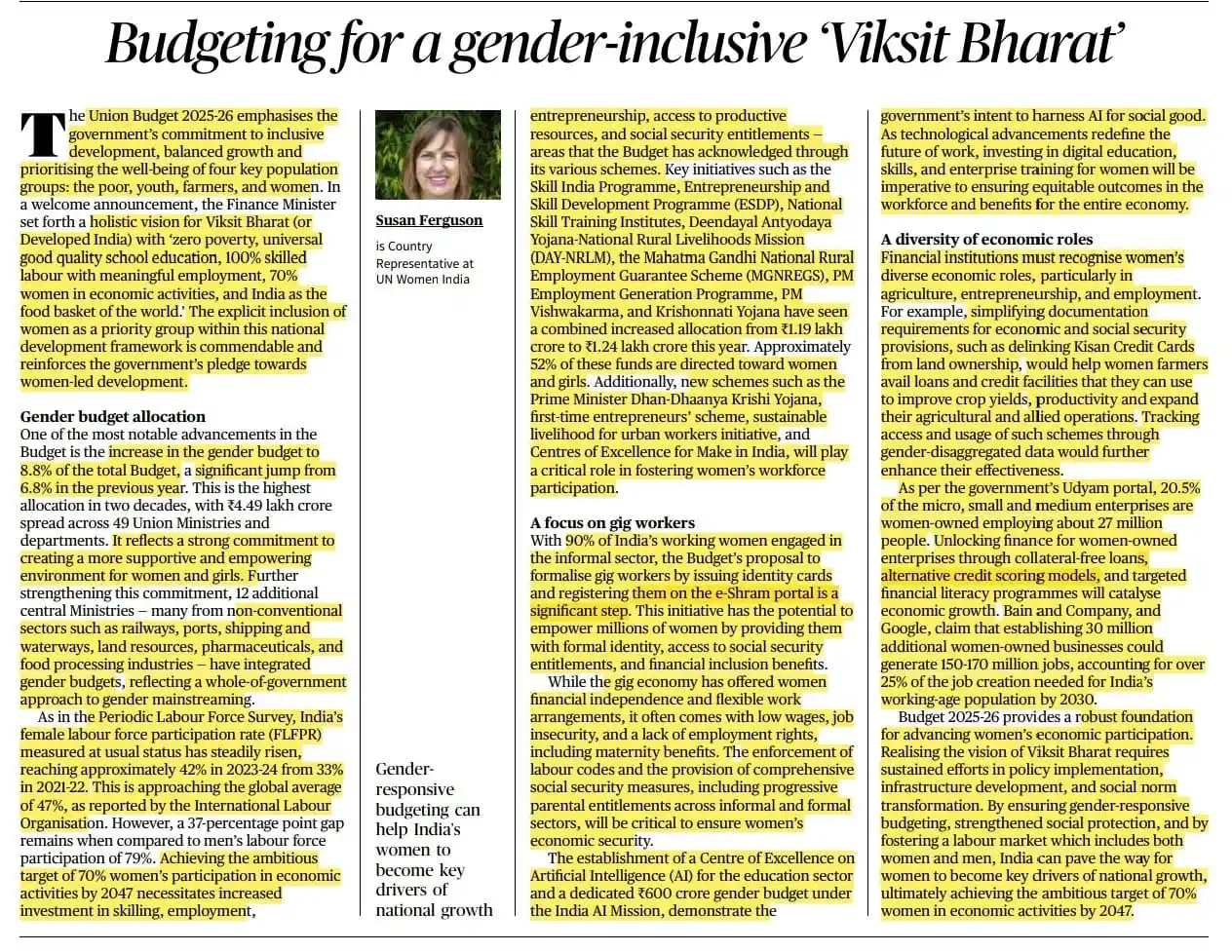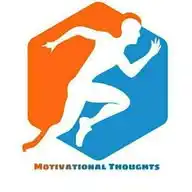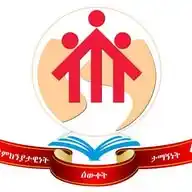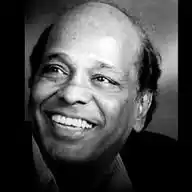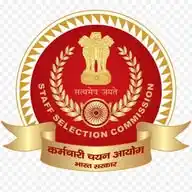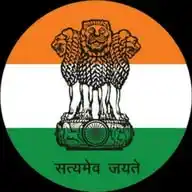
UPSC Society UPSC UPSC UPSC ™ UPSC UPSC Upsc UPSC UPSC™ Upsc UPSC UPSC UPSC UPSC UPSC UPSC UPSC Upsc
9.3K subscribers
About UPSC Society UPSC UPSC UPSC ™ UPSC UPSC Upsc UPSC UPSC™ Upsc UPSC UPSC UPSC UPSC UPSC UPSC UPSC Upsc
Main channel cse exam https://whatsapp.com/channel/0029Va9AbAbJZg46NAznuX2y *Subject wise channel* Upsc society https://whatsapp.com/channel/0029VaWufLw6BIEknk3zHz2R Internal security https://whatsapp.com/channel/0029VabMGoV7YSczWUxg4d2F Art and culture https://whatsapp.com/channel/0029VaeNm6EEquiVREmJrl0F Mindmap https://whatsapp.com/channel/0029VaazqwV8aKvFQwYJlw02 Ethics https://whatsapp.com/channel/0029VaaWX4aFCCobFmqcRL3q ✅ CSAT https://whatsapp.com/channel/0029Vabv60LLCoWsu9kNQl1I ✅Upsc PIB https://whatsapp.com/channel/0029VaGjIdyChq6H86MD643x ✅Science & technology https://whatsapp.com/channel/0029Va9T3U31Hspr7kNcod0g ✅Environment & ecology https://whatsapp.com/channel/0029VaBiYQY2Jl8LDfC2YZ3j ✅Upsc mains facts https://whatsapp.com/channel/0029VaQy4BBJUM2TXmGueJ2T Mains pyq model answer https://whatsapp.com/channel/0029VajSp953bbV4XmAbtb26 ✅Geography Mapping https://whatsapp.com/channel/0029Va9S9pL0rGiGyEIEUe1b ✅Polity governance https://whatsapp.com/channel/0029VaGDohxKrWQz0GZ5Fa1v ✅Prelims tricks https://whatsapp.com/channel/0029VaEPayu2v1InlnkS6K06 ✅Anmol vachan motivational https://whatsapp.com/channel/0029Va42j79297531AcAOm1X ✅Essay ethics example https://whatsapp.com/channel/0029VaHNc8mDuMRWb1Zybf33 ✅Economy agriculture https://whatsapp.com/channel/0029VaHOmr34inorlsEbVc2X ✅History culture https://whatsapp.com/channel/0029VaLZoxWBfxo4bstnop1k ✅Hindi medium https://whatsapp.com/channel/0029Va4ktYl8V0ttJgAhH70b ✅UPSC PYQS https://whatsapp.com/channel/0029VaH6GnYBvvsX99pHCG1C Upsc IR https://whatsapp.com/channel/0029VaMyvdJJ3jurNz6pne3z Government schemes https://whatsapp.com/channel/0029VaYZ5ls5Ui2c7bNRo62I
Similar Channels
Swipe to see more
Posts

🔆 Key Themes from The Power by Naomi Alderman 📍 Women Gaining Literal and Symbolic Power ✅ The novel envisions a world where women gain the ability to generate and control electricity. ✅ This newfound power challenges traditional notions of strength and authority. 📍 Reversal of Gender Dynamics ✅ Historically, men have held dominant power, but the shift forces society to rethink gender roles. ✅ Women, once marginalized, become the dominant force, upending social hierarchies. 📍 Personal and Social Impact ✅ The story follows Roxy, Tunde, Margot, and Allie, each experiencing the change differently. ✅ The shift influences emotions, personal relationships, and global society. 📍 Double-Edged Nature of Power ✅ Power liberates women from oppression but also introduces the risk of corruption and violence. ✅ The novel questions whether power inherently leads to justice or simply shifts the cycle of dominance. 📍 Myth, History, and Reality Interwoven ✅ The narrative blends mythic and biblical imagery (e.g., the "Book of Eve") with modern events. ✅ It highlights that the struggle for power is an ongoing historical theme. 📍 Societal and Political Implications ✅ Governments, institutions, and families must restructure their systems in response to this change. ✅ The novel raises questions about governance and whether existing structures can withstand such a radical shift. #ThePower #GenderRoles #Society #PowerDynamics

Best way to analyse your preparation is by solving MCQ. 👇 https://t.me/addlist/MTMS_kBxayEwZmZl https://t.me/addlist/MTMS_kBxayEwZmZl Subject wise channel

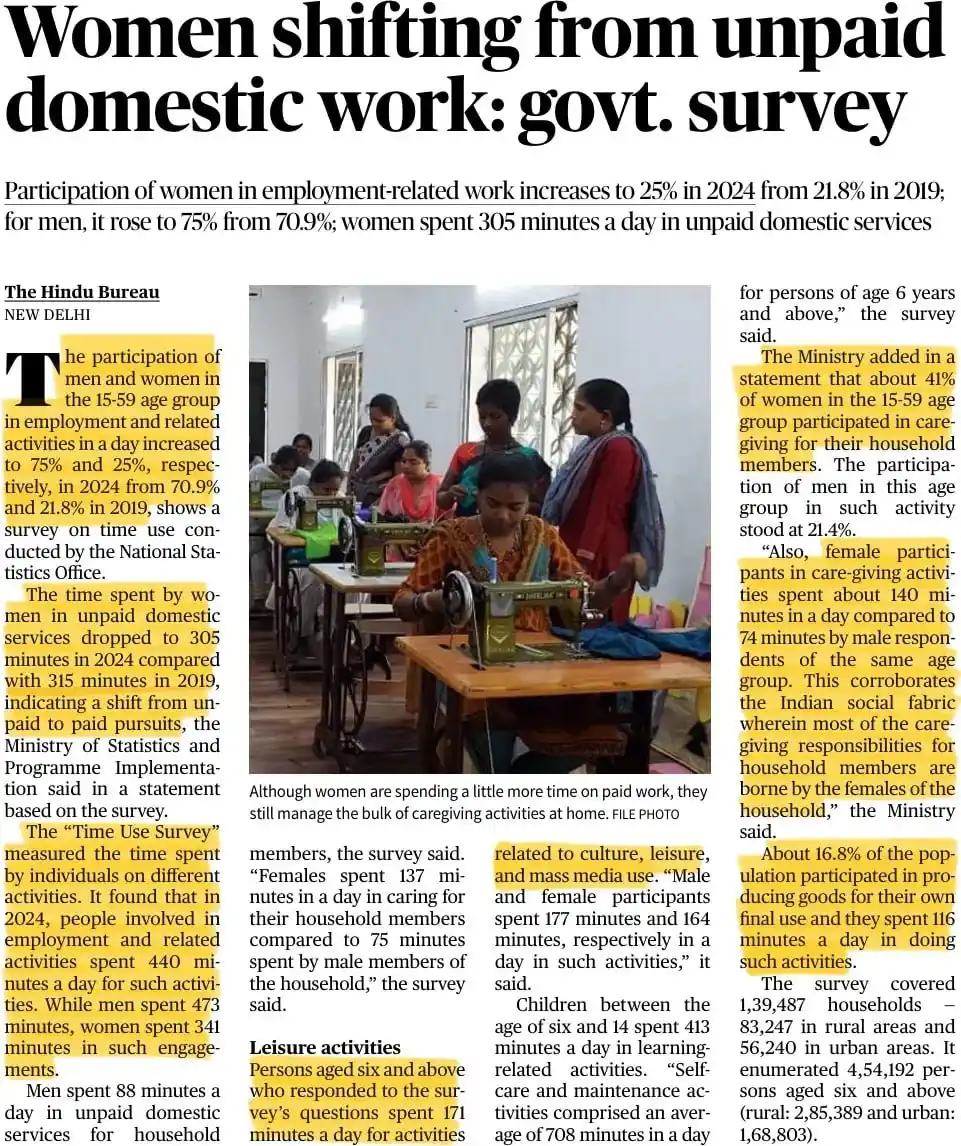

STILL A MAN´S HOUSE: GENDER GAP PERSISTS
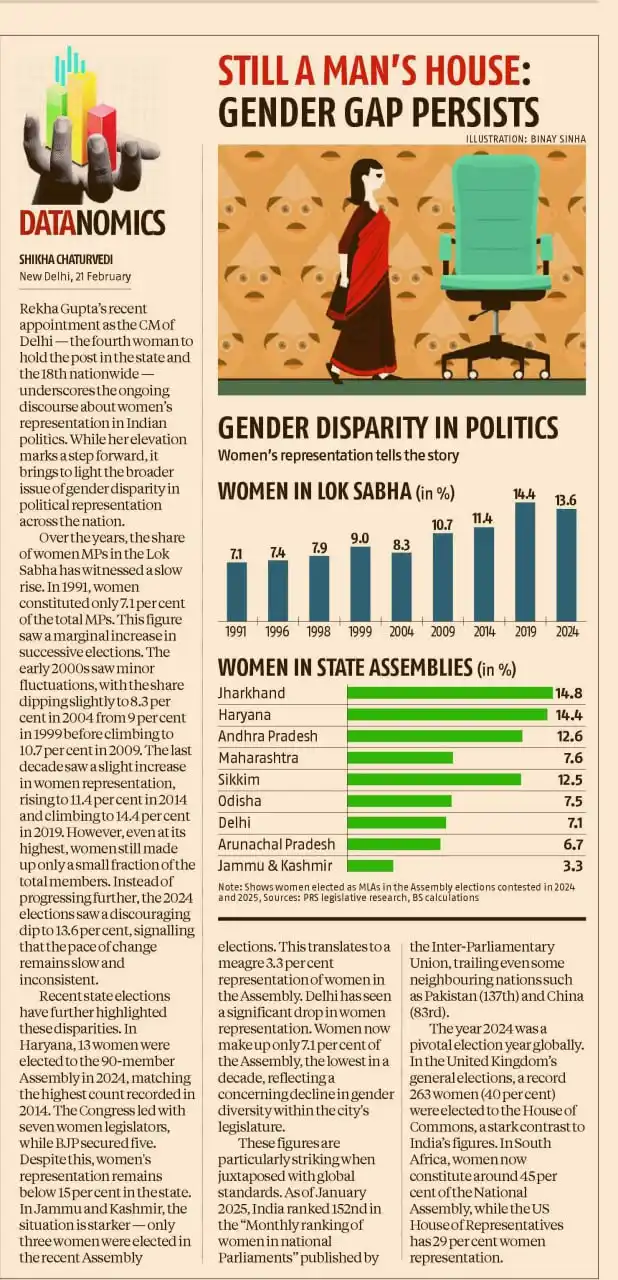

🔆World Day of Social Justice ✅ It is an initiative of the UN specifically led by the International Labour Organization (ILO) to promote social justice, equality, human rights, and fair opportunities for all. ✅It was designated by the UN General Assembly on 26th November 2007. 📍Pillars of Social Justice: ✅Role of ILO: ILO unanimously adopted the Declaration on Social Justice for a Fair Globalization on 10th June 2008 in response to the World Day of Social Justice. ✅It expands upon the Philadelphia Declaration 1944 and the Declaration on Fundamental Principles and Rights at Work 1998. ✅In 2009, ILO launched Social Protection Floors that ensure basic social security to prevent or reduce poverty.
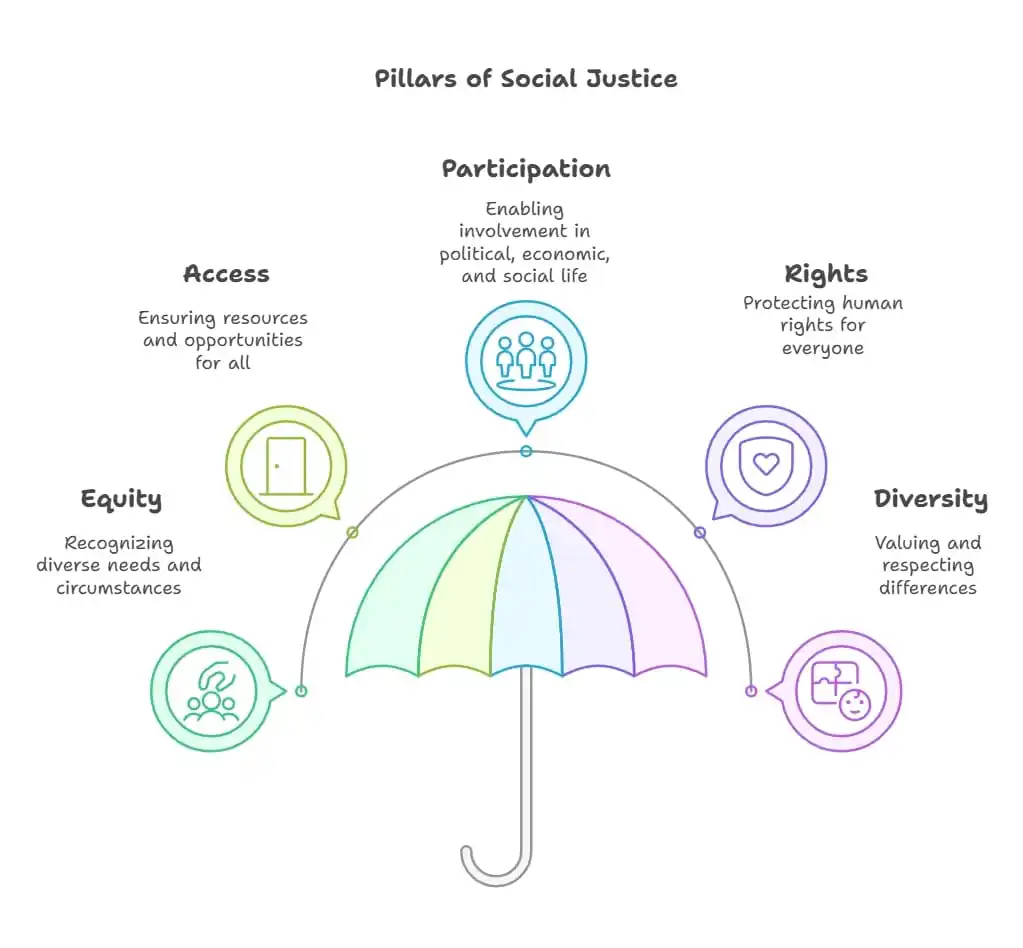

🔆 Analysis of declining school enrollment in India based on U-DISE+ data, linking it to demographic changes and implications for India's demographic dividend. Key Points: ✅Declining Enrollment: 🔸15.5 million drop (6%) since 2018-19. 🔸24.51 million drop (9.45%) over the past decade. 🔸Elementary level most affected: 18.7 million drop (13.45%). ✅Data Analysis: 🔸Decade-long data (2014-15 to 2023-24). 🔸Correlation with population changes in relevant age groups. 🔸Aadhaar seeding to eliminate multiple enrollments. 📍Government vs. Private Schools: ✅Government schools: Significant decline, especially elementary level. ✅Private unaided schools: Marginal increase overall, senior secondary level growth. 📍Demographic Factors: ✅Fertility rate decline to 2.01 in 2022. ✅Decline in school-going population (6-17 years). ✅Shift in population bulge to older age groups. Implications: ✅End of demographic dividend era. ✅Population aging before becoming rich. ✅Shrinking working-age population. ✅Decline in number of schools. Social Impact: ✅Affects poor and marginalized sections of society most. ✅Impact on higher education in the future. Possible Questions: ✅Prelims: Which of the following is/are a factor(s) contributing to the decline in school enrollment in India, as per the article? Declining fertility rate. Aadhaar seeding to eliminate multiple enrollments. Increase in the number of private schools. (a) 1 only (b) 1 and 2 only (c) 2 and 3 only (d) 1, 2 and 3 ✅Mains: "The declining trend in school enrollment in India, as highlighted by the U-DISE+ data, has significant socio-economic implications for the nation's future." Discuss this statement, analyzing the factors contributing to this trend and suggesting measures to mitigate its impact.
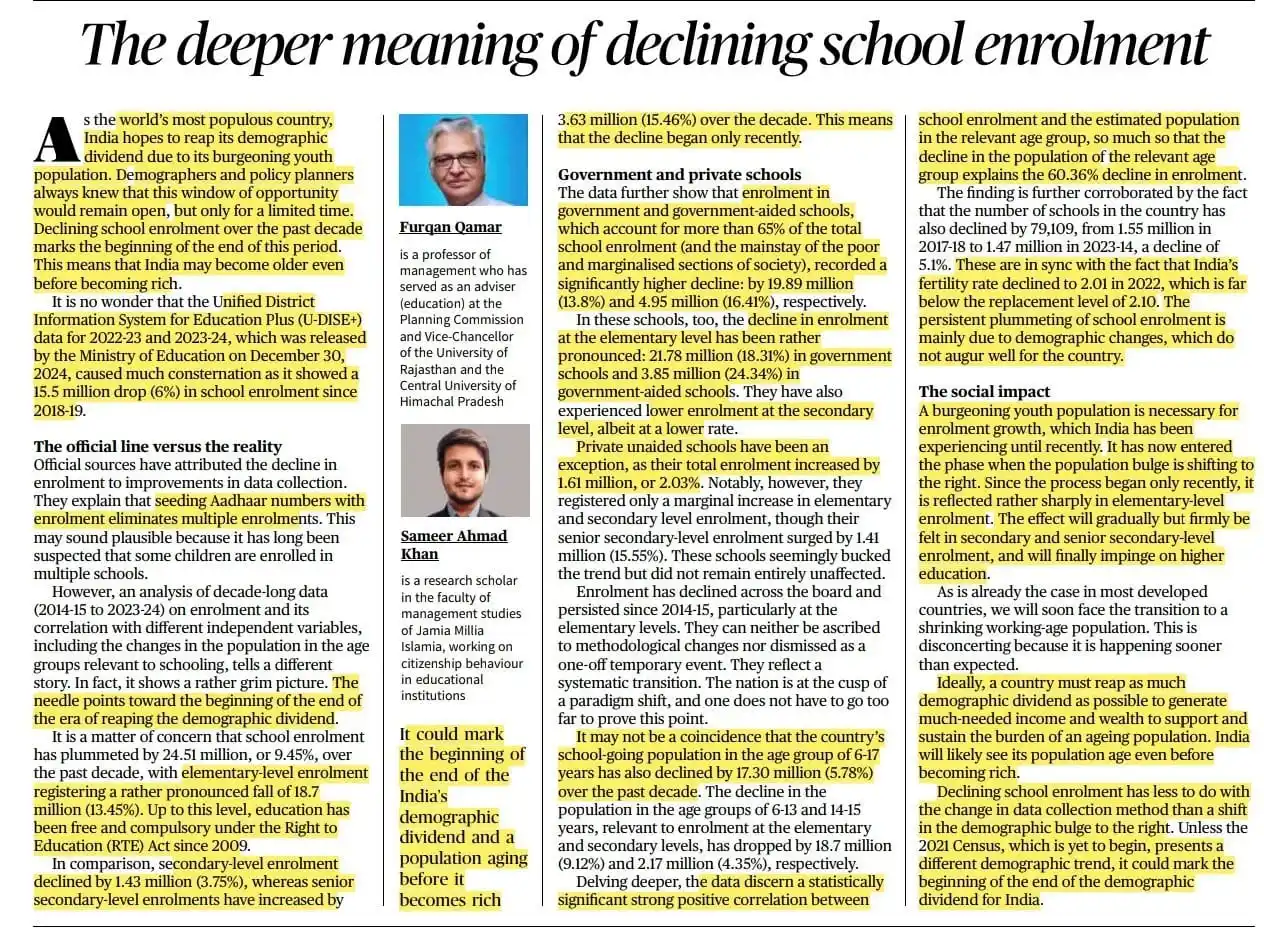

🥳🥳 630+ students cleared prelims from this channel. This is an initiative by IAS IPS IRS officers from Delhi. Link to join: 👇👇 https://t.me/addlist/IGgFquAcxa41NzM1 https://t.me/addlist/IGgFquAcxa41NzM1

🔆 Key Takeaways from "Sex and Violence: Marriage Should Not Provide Immunity for Sexual Violence" 📍 High Court Ruling on Marital Consent ✅ The Chhattisgarh High Court ruled that "unnatural sex" by a husband in marriage is not an offence, relying on the presumption of consent. ✅ A man convicted by a sessions court for forced physical relations, allegedly leading to his wife’s death, was acquitted by the High Court under Exception II of Section 375 (IPC), which does not recognize marital rape unless the wife is under 15. ✅ The Supreme Court had previously raised this age limit to 18 in Independent Thought vs Union of India (2017). 📍 Legal Ambiguity Around Marital Rape ✅ India remains one of the few countries where marital rape is not a criminal offence. ✅ The Supreme Court deferred hearings in October 2024 on pleas to criminalize marital rape, signaling the need for legislative action. ✅ The Union government fears criminalizing marital rape may "undermine the institution of marriage." 📍 Prevalence of Spousal Violence ✅ Data from National Family Health Survey (2019-2021) shows 32% of ever-married women aged 18-49 in India faced physical, sexual, or emotional violence from their spouses. ✅ Only a small percentage seek help, exposing societal and legal gaps in addressing domestic sexual violence. 📍 Call for Urgent Legal and Social Reforms ✅ The ruling underscores the urgent need for legal clarity and societal change in addressing sexual violence within marriage. ✅ Despite constitutional safeguards, they remain ineffective without legal recognition of marital rape as a crime. ✅ Society must evolve towards mutual respect, dignity, and consent, rather than granting immunity for sexual violence within marriage. #LegalReforms #MaritalRape #WomenRights #society

🔆Current Context: Analysis of declining marriage rates in China, its link to population decline, and the government's attempts to address the demographic crisis. Declining Marriages: ✅Statistics: 6.1 million couples registered in 2024 (lowest since 1986), 20.3% drop from 2023. ✅Reasons: Rising cost of living, urban unemployment, 44% urban women not wanting marriage. ✅Impact: Compounds population decline, affecting economic future and stability. Population Decline: ✅Trend: Consistent decline in recent years, deaths exceeding births in 2022. ✅One-Child Policy: Primary reason, introduced in 1980s. ✅Policy Reversal: Two-child (2016) and three-child (2021) policies failed to reverse trend. ✅Unbalanced Sex Ratio: Desire for male child led to imbalance. ✅Ageing Population: Working-age (19-59) decline, 22% population above 60 (potentially 50% by 2050). ✅Pension Pressure: Pension fund may run out by 2035, retirement age increased, temporary solution. ✅Increased Demand: Caregiving, healthcare, kindergarten closures. ✅Economic Impact: Direct impact on economic future and stability. 📍Government Response: ✅Financial Support: Incentives fail to counter high cost of raising a child. ✅Top-Down Approach: Policies and diktats, without addressing social realities. ✅Xi's Speech: Calls for "new culture of marriage and childbearing," reflects gap between party and society. ✅Control & Command: CPC still attempts to control society, believes it "knows best." ✅Safeguarding Power: Policies seen as prioritizing party power over societal needs. Possible Questions: ✅Prelims: Which of the following is/are a reason(s) for the declining marriage rates in China, as mentioned in the article? Rising cost of living. Urban unemployment. Successful implementation of the three-child policy. (a) 1 only (b) 1 and 2 only (c) 2 and 3 only (d) 1, 2 and 3 ✅Mains: "China's demographic challenges, stemming from its past population policies and evolving social realities, pose a significant threat to its future economic and social stability." Discuss this statement, analyzing the factors contributing to the declining marriage and birth rates in China and evaluating the effectiveness of the government's responses.


🔆Current Context: Analysis of India's Union Budget 2025-26, focusing on its gender-inclusive aspects and potential impact on women's economic participation. 📍Key Initiatives & Allocations: ✅"Viksit Bharat" Vision: Includes women as a priority group, aiming for 70% women in economic activities by 2047. ✅Gender Budget: Increased to 8.8% of the total budget, ₹4.49 lakh crore across 49 ministries. 12 additional ministries integrate gender budgets. ✅Schemes & Programs: Increased allocation for Skill India, DAY-NRLM, MGNREGS, etc. ~52% of funds directed towards women & girls. New schemes like PM Dhan-Dhaanya Krishi Yojana, first-time entrepreneurs' scheme, and sustainable livelihood for urban workers initiative. ✅Focus on Gig Workers: Formalizing gig workers through identity cards and e-Shram portal registration, aiming to provide access to social security. ✅AI for Education: Centre of Excellence on AI for education sector, ₹600 crore gender budget under India AI Mission. 📍Financial Inclusion & Entrepreneurship: ✅Women-owned MSMEs: 20.5% of MSMEs are women-owned. Focus on unlocking finance through collateral-free loans, alternative credit models, and financial literacy programs. ✅Potential Job Creation: 30 million additional women-owned businesses could generate 150-170 million jobs. 📍Labor Force Participation: ✅FLFPR Increase: Rose to ~42% in 2023-24, but still significantly lower than men's (~79%) and below the global average (~47%). ✅Target: Achieving 70% women's participation by 2047 requires further investment in skilling, employment, and infrastructure. 📍Concerns & Challenges: ✅Informal Sector: 90% of working women are in the informal sector, highlighting the need for comprehensive social security measures and enforcement of labor codes. ✅Implementation: Realizing the "Viksit Bharat" vision requires sustained efforts in policy implementation, infrastructure development, and social norm transformation. ✅Overall Assessment: The budget lays a foundation for advancing women's economic participation, but achieving ambitious targets requires sustained efforts, addressing structural challenges, and ensuring effective implementation of policies and schemes. Possible Questions: ✅Prelims: Which of the following is/are a focus area(s) in the Union Budget 2025-26 related to women's economic empowerment? Increasing the gender budget allocation. Formalizing gig workers through identity cards and e-Shram portal registration. Establishing a Centre of Excellence on AI for the education sector. (a) 1 only (b) 2 and 3 only (c) 1 and 3 only (d) 1, 2 and 3 ✅Mains: "The Union Budget 2025-26 demonstrates a commitment to women's economic empowerment, but translating policy pronouncements into tangible outcomes requires addressing deep-rooted structural and socio-cultural barriers." Discuss.
